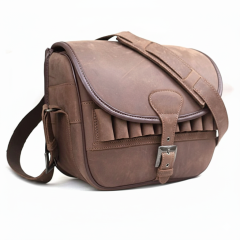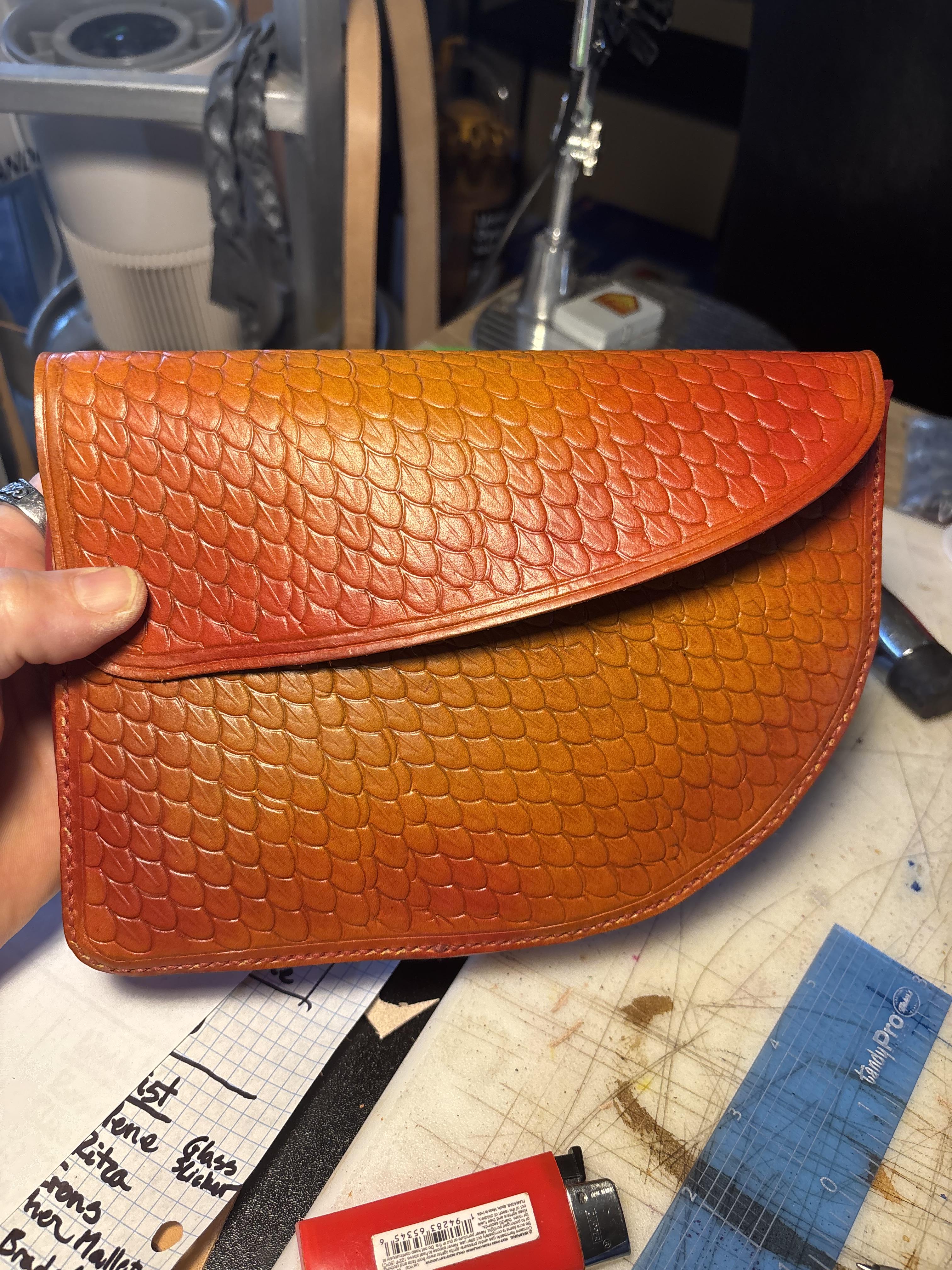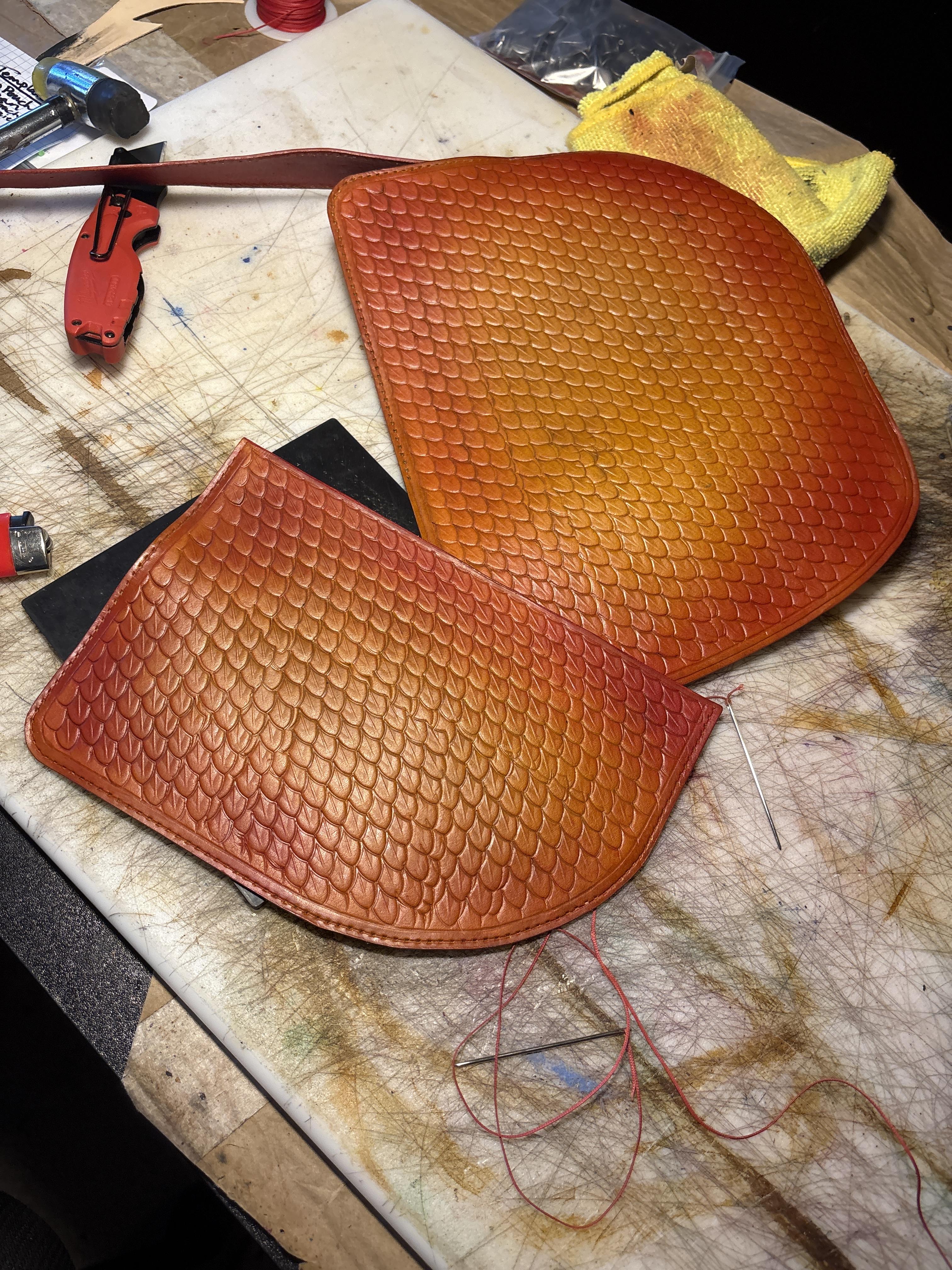
ThisIsMyFirstRodeo
Members-
Posts
133 -
Joined
-
Last visited
Content Type
Profiles
Forums
Events
Blogs
Gallery
Everything posted by ThisIsMyFirstRodeo
-
If the header didn’t give it away, I’m back to my first rodeo… I haven’t worked with fur before. Are there any tips or tricks for working with a rabbit pelt? I’m making Dieselpunk’s elf hat, and I intend to use the pelt for the trim, so nothing beyond basic. I’m just unsure of new materials these days… Thanks, and may you never burn your bacon! — AZR
-
How to prevent overglue?
ThisIsMyFirstRodeo replied to ThisIsMyFirstRodeo's topic in How Do I Do That?
Guess I should add in that regardless of what kind of adhesive, I stitch everything… -
How to prevent overglue?
ThisIsMyFirstRodeo replied to ThisIsMyFirstRodeo's topic in How Do I Do That?
So I didn’t get the lid closed enough on my cement (weldwood) and while attempting to thin it out with some acetone yesterday, it almost seemed to seize up on me. (Today, it actually looks quite usable though… 😉) Although I was working a different project yesterday (on a timeline), I still had to glue/cement/adhere a few pieces. But, because of the issues with the cement, I wound up using Gorilla wood glue. Seems like it did the trick in a pinch, even if less than ideal. Hopefully I’ll clear my production board so I can move back to my belt and keep going… Thanks guys, AZR -
Hey all, So I’m making a padded belt, but I’m wary of getting cement on the face/grain of the strap. Is there a way to protect/prevent it? I had the thought of just masking it off with tape, but in the past, tape has seemed to deglaze the grain. Thoughts? Thanks, and may you never burn your bacon. — AZR
-
Hey all! Hope everyone had a great thanksgiving yesterday. Well, I was using a scrap of veg-tan (from a mixed bag of remnants) that I believe is heritage based on the color and texture. Anyway, as I was buffing it to a high sheen, the pebbled texture became smooth. I haven’t yet worked with heritage, but is this normal and something I should expect? (I’m hoping the side-by-side pic actually uploads this time…) Just my first rodeo with heritage leather, AZR IMG_7951.HEIC Ok, not how I was hoping it would upload, but I’m not gonna troubleshoot anymore this morning…
-
Real Leather Brown Canvas Cartridge Bag
ThisIsMyFirstRodeo commented on Bantoro craft's gallery image in Gallery- Our Leatherwork
-
Must be Monday…
ThisIsMyFirstRodeo replied to ThisIsMyFirstRodeo's topic in Leatherwork Conversation
Well, I admit that stitching the strap by hand took considerably longer than I expected. Yesterday I finally finished the other piece of the strap (2pc for a crossbody bag) with only a few more snafus, but it’s done, and it’s for the missus, so the flaws aren’t a concern. I hope… Hope everyone had a great thanksgiving, and may you never burn your bacon! — AZR PS ok, well 3 times I attempted to post a pic of the final piece, but I failed. There’s some irony here… -
I’m calling a Mulligan. Just pierced my thread on the first backstitch. Im going back to bed… Catch y’all on the flip side, — AZR
-
2 follow-up questions: — After thinning, do I need to wait before using it? — And should I expect any difference in how it works? I added acetone to the cement can, and I *think* I stirred it in well enough, to an even consistency with no liquid pooling. Definitely thinner, though I am on the fence about thinning further. But, as a tester, I glued up a small tab for a box (maybe ½ sq.in. if it matters), and something seemed… different somehow. Wish I had the words to describe it. Thanks again, — AZR
-
Hey all, Ok, at least it’s not a completely noob question this time… I’m using weldwood as my contact cement, and as I reach the bottom of the can, it seems like it is much more viscous and more difficult to use for small/delicate/detail places. I’m sure that this is from not having stirred the can enough when it was full, but it is the first canned cement I have used (previously used the squeeze tubes of Barge). Learning curve and all… Anyway, is there a way to thin the cement to a more desirable/usable viscosity? TIA for the advice, and may you never burn your bacon! 😉 — AZR
-
That’s really awesome for the inmates (aside from the program being scrapped…)! While I was living in Washington, a penitentiary in Oregon had a similar program, but textiles. Great jeans and flannel. Pendleton something or other... I have no clue if the pens down here have work/trade programs like that. — AZR
-
I haven’t seen a bag like that before. Very cool! Maybe Tandy’s mini saddle template could be incorporated? (I have no clue about the size of the finished product) — AZR
-
Springfield Leather Co has a free template for a mini-saddlebag-type purse. I’ve recently made a couple bags from the template, and personally, I think it’s a cool design. It is reminiscent of motorcycle saddlebags versus horseback, but check it out, maybe it’s up your alley… Hope there’s no copyright issues here, but it is free… — AZR MiniSaddleBag.pdf
-
As always, you come through with some great insight. And yes, the airbrush is a light-duty cake decorator, but maybe it’ll give her a gift idea. After all, Christmas is coming 😉 I think (hope?) I have finally made my case to spend the extra $15 on the Pro Dye to not stress over the potential for bleed, and to skip the topcoat step and save time. Regardless, I still want to explore the airbrush application method. My initial project resulted in a halfway decent sunburst, so I’m excited to see what I can do with a little experience. — AZR
-
Will do, and thank you for your input. I did use water to dilute, but maybe there’s enough of a difference between Resolene and Pro Resist to give different results. I haven’t worked with Resolene yet to test/experiment… The wife did give me her airbrush though, so I’ll probably set the Preval down. But I have started to cut the resist with water instead of using full-strength, and I cut my dye to various dilutions with 91% iso alc. I have yet to put it through the airbrush though, so I’ll find out soon if I should or not. General question for the audience though: Has anyone sprayed NFO? And how were your results? — AZR
-
Note to self: Just don’t. Basically my experience was from attempting to spray a 50% dilution. The resist started gumming up into the “white glue”-type sludge, clogging the nozzle. Another sign of a mistake is the freeze warning on the side of the bottle. And the propellant in the cartridge is well below freezing as it’s released. I was doing my best to use short bursts to prevent the nozzle from freezing over, but who knows how successful that was. At least I’m only down a cartridge and some time, though what did spray seemed to lay down surprisingly even. Perhaps an airbrush is still a possibility for application, but definitely not with the Preval system. (It did work wonderfully for my dye though!) Learn from my experience so you don’t have to make the same mistake 😉 And may you never burn your bacon… — AZR
-
Ok, simple question (maybe)… Does water- vs oil-based dye affect how you use NFO? Is the typical oil/water separation even a concern? Ive been watching some videos from the University of YouTube, and I’ve noticed that they’re all using Fiebings Pro, and not water-based (I prefer the Pro dye myself, but I happen to have a water-based dye for this project), and I don’t want to ruin a piece by lifting or smearing the dye. TIA, AZR
-
Aaaaaand I feel even more inadequate…
-
It’s a handbag, 3-4oz econo veg tan, probably closer to the 4oz end. I was hoping to attempt oiling/conditioning to soften it and make it a bit more pliable (I know I would have only limited results, but I was going to try anyway), but because I made the mistake of using a water-based dye, I had to seal the bag with Pro Resist (it’s what I have on my shelf), which leads to the conundrum of how to best treat the leather. — AZR




